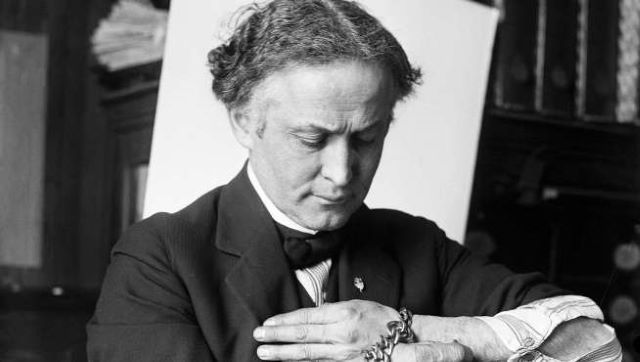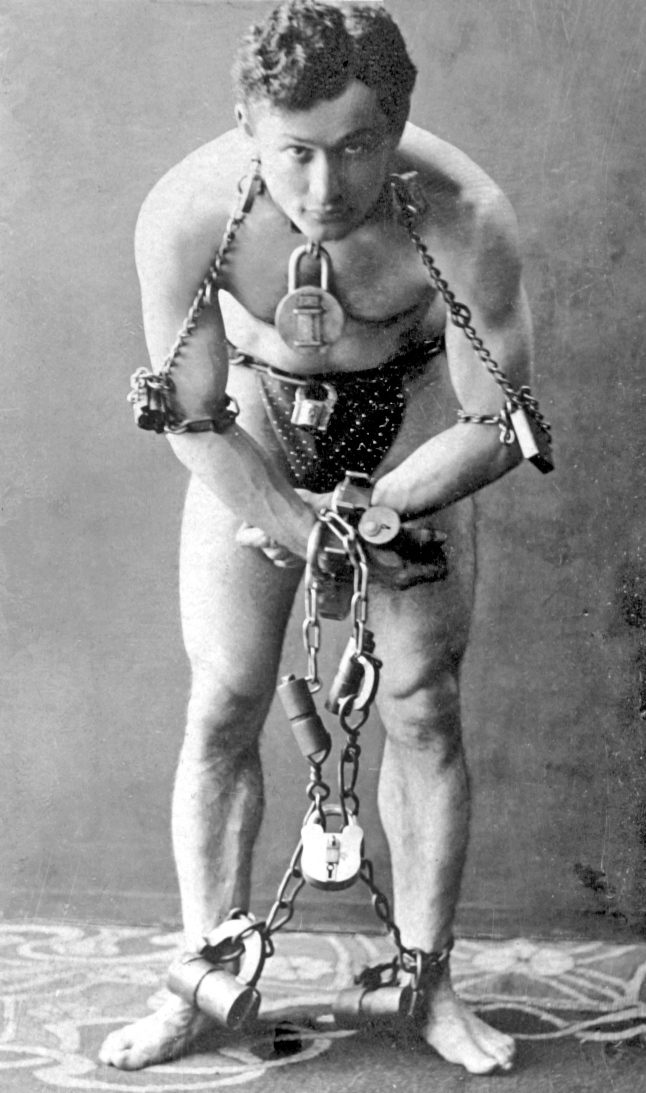Harry Houdini is one of the most famous illusionists of all time, a pioneer of many modern techniques, and a master of liberation (escape) tricks. He claimed that no prison could hold him, no knots, no chains, no shackles, no shackled hands or feet could keep him from freedom, and he proved it to the whole world. In his later performances, he denounced spiritualists and was convinced that all mediums were charlatans. Despite his passing more than 80 years ago, he is still considered one of the most interesting and mysterious personalities, and many illusionists strive to replicate Houdini and draw inspiration from him.
Harry Houdini was born Erik (later called Ehrich) Weisz in Budapest, Hungary, on 27 March 1874, to a Jewish family of seven children. In 1878 he moved with his family to the United States of America. He was an athlete as a child, took gymnastics, amateur boxing, was a champion runner and trapeze artist, and nicknamed himself “the prince of the air”. All this has contributed to the development of his stamina and strength for further activities. When he began to practise magic, he coined the pseudonym Harry Houdini after two famous illusionists from whom he took his cue (Jean Eugene Robert-Houdin and Harry Keller). In 1913, this stage name became an official name in documents.
The magician’s career, which he began in 1891, focused mainly on traditional card and handcuff tricks, performing in museums and circuses, without attracting much interest or success. In 1893, he met his colleague Bess (full name Wilhelmina Beatrice Rahner), whom he married a year later. Bess became not only his life partner but also his stage partner. A decisive event in Houdini’s career was his meeting in 1899 with the show business manager Martin Beck, who, impressed by the handcuff tricks and seeing Harry’s potential, encouraged him to concentrate on escape numbers. After a world tour, he returned to America in 1904 and was recognised as a world-class illusionist, able to free himself from straitjackets, shackles and chains, even while dangling from a rope high above the ground or submerged in water. During his tours in various countries (France, Germany, the Netherlands, Scotland, Russia, etc.), he challenged the local police to ask to be arrested so that he could escape from prison. He was usually stripped naked and searched before being imprisoned, but the escapes were always successful. This earned Houdini the nickname “King of the Handcuffs”, and people flocked to his performances in droves, it is said that sometimes the doors of the theatre had to be removed in order to allow the crowds to get inside. Houdini himself described some of the secrets in books that were later published. He told how one could sneak in an all-rounder, swallow and then unlock a small key, or unlock a lock/handle with the correct use of body force.
Houdini is not only famous in magic, but also in other fields. In 1910, he flew across Australia in his own plane; he is recognised as the third person to do so, although he called himself the first. He tried his hand at the film industry, producing, directing and acting (“The Man from Beyond”, “Terror Island”, “The Grimm Game”, “The Master Mystery” etc.). He mainly filmed his performances in the open air, but got less success than he had hoped for, so he gave it up. Not all of the films have survived, but some of them can be found on the internet. In 1919, he became president of Martinka and Co., the oldest and largest magicians’ company in the USA, a title he held until his death. Houdini is believed to have been a spy for the American government, collecting information on European political leaders and privileged persons for many years. Under the guise of touring many countries, he had access to law enforcement bodies, etc., but this has not been confirmed or denied. This conspiracy theory is extensively discussed in William Kalush and Larry Sloman’s book “The Secret Life of Houdini – The Making of America’s First Superhero” (2007).
One of his most successful performances was the Escape in 1913, which Houdini kept in his repertoire for many years. The magician was locked in a glass-steel barrel filled with water, suspended upside down, and had to hold his breath for more than 3 minutes to escape. The audience was in awe of the spectacle, amazed by the artist’s bravery and at the same time breathless. Another of the most spectacular performances of the time was in 1918. An elephant was impaled in a New York theatre. The 10,000-pound animal was introduced into a wooden room with curtains drawn, and when the curtains were pulled back, the room was empty. No longer surprised by rabbits in illusionists’ hats, Houdini abstracted the audience with an animal of slightly different dimensions. Even though Houdini himself described some of his tricks, over time people have discovered even more. The best example is the exhibition at the Wisconsin Museum in 2004. It clearly and vividly showed the most important tricks of the illusionist and the principles of their operation. The unwritten rule among magicians not to reveal how an illusion is performed was broken, and the profession was somewhat shocked by the exhibition.

In the mid-19th century, interest in Spiritualism was growing rapidly in the USA. It was believed that there was a spiritual world beyond death that could be contacted through mediumship. Queues would form outside the doors of practitioners to talk to their loved ones. When Harry’s mother died in 1913, he also visited several mediums and came to the conclusion that they were impostors and that communicating with the dead was nothing more than a fiction, a way for charlatans to make a buck. The Scientific American magazine committee offered a reward/prize of 2,500 dollars to anyone who could pass a test and prove that he or she had real psychic abilities to contact the dead. Mina Crandon (otherwise known as Margery) was the most famous medium of the time who communicated with her brother. She passed the test and convinced the committee, but failed to convince Houdini. He, also a member of the committee, asked to be allowed to assess Margery’s powers. Over several months, he presented detailed evidence of Margery’s manipulation of the board and other objects, unmasking her, and no one was able to win the prize.
This act brought Houdini into conflict with his friend Arthur Conan Doyle, author of Sherlock Holmes. Doyle deeply believed in the reality of the connection with the otherworld, in spiritual powers, and considered Houdini to have them; from good friends to public enemies. Houdini was able to provide rational explanations for the actions of each of the mediums, or even to replicate the tricks, and continued to do so. Having noticed that the public was very fond of the so-called “spirit séances”, he filled the duration of his programme with at least a third of them. He demonstrated chairs and other equipment floating in the air, and utilizing a smoke screen or a mirror, he would seemingly see and communicate with the summoned spirit. He was so deeply involved in non-existent (or existing) spiritualism that he made a pact with his wife: on each anniversary of his death, Bess would organise a spiritualism session. If the afterlife did exist, Harry would be sure to contact her. His wife faithfully maintained this arrangement for 10 years and then simply “released” her husband’s ghost. Now, traditionally, séances are held every year by Houdini’s followers in one of the museums founded in his honour.
Workaholic, perfectionist, interested in everything about death, fascinated by the macabre, even bought an electric chair and performed tricks with it in a prison. He often risked his life, and his fate, but met death unexpectedly. Harry Houdini died on 31 October 1926 of peritonitis – a blow to the abdomen caused a ruptured appendix and complications. He was buried in New York, next to his parents, with a letter from his mother under his pillow. His death is commemorated annually by the American Magicians’ Association in a “broken magic wand” ceremony at the cemetery. In 2002, a postage stamp with Houdini’s portrait was issued in the USA. A museum is opened in Pennsylvania and another museum and a plaque in Ontario. These places are well visited and well appreciated even after all these years. No one can deny the title of the greatest magician of all time, the excellence, the merits of Harry Houdini.




